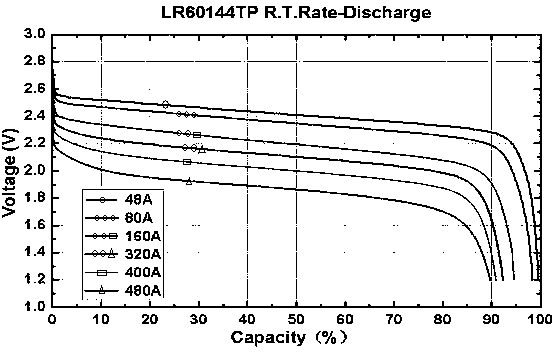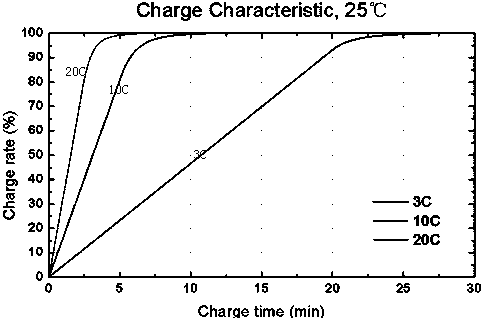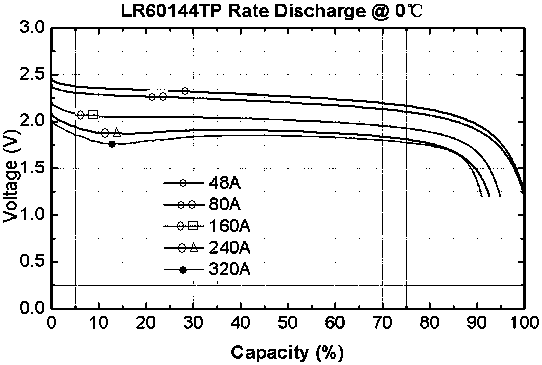Preparation method of graphene low temperature battery
A low-temperature battery and graphene technology, which is applied to battery electrodes, secondary batteries, battery pack components, etc., can solve the problems of reducing the specific energy of the battery system, poor conductivity, etc., and achieve low internal resistance, excellent charging performance, The effect of high cycle performance
- Summary
- Abstract
- Description
- Claims
- Application Information
AI Technical Summary
Problems solved by technology
Method used
Image
Examples
specific Embodiment approach 1
[0032] The preparation method of the graphene low-temperature battery of the present embodiment, such as Figure 6 As shown, the method is realized through the following steps: Step 1, the homogenization process of the slurry required for coating the positive electrode sheet of the battery is carried out through the lithium manganate positive electrode, the binder and the conductive agent. After the slurry is prepared, it is ready to be coated. cloth;
[0033] Step 2. Add graphene to the conductive agent, combine with the binder to carry out the homogenization process of the slurry required for coating the negative electrode sheet of the battery, and prepare the coating after the slurry is prepared; wherein, graphene and lithium titanate negative electrode Material compounding is to make tetrabutyl titanate, single-layer graphene, P123, and tert-butanol into a titanium source dispersion, and use lithium acetate dihydrate, deionized water, and tert-butanol to make a lithium sou...
specific Embodiment approach 2
[0039] The difference from the first embodiment is that in the preparation method of the graphene low-temperature battery of the present embodiment, in the first step, lithium manganate, a binder and a conductive agent are used to homogenize the slurry required for coating the positive electrode sheet of the battery Process, the process of preparing the slurry is to select the lithium manganese oxide with the number of 90-98%, the binder with the number of 2-4%, and the conductive agent with the number of 2-4% to put the mixture together In the tank, mix at a stirring speed of 30r / min, and then add PVDF-1700 binder with a solid content of about 8% using NMP as a solvent in three times: the first time adding 15-25% of the total glue , Stir for 1-2 hours at a speed of 3000r / min until the slurry is doughy; then open the mixing tank for scraping, and then add 20%-30% of the total binder, at 3000r / min 1-2 hours at the rotating speed to make the slurry preliminarily mix and appear p...
specific Embodiment approach 3
[0040] The difference from specific embodiment 1 or 2 is that in the method for preparing a graphene low-temperature battery in this embodiment, in step 2, the negative electrode lithium titanate, a binder, and a conductive agent containing a conductive graphene slurry are used to coat the battery The homogenization process of the slurry required for the negative pole piece, the process of making the slurry is as follows, the main difference from the general battery is that graphene is introduced into the conductive agent and exists in the form of conductive slurry, and in the uniform process Adjustments need to be made, specifically:
[0041] Select 90-95% lithium titanate, 2-10% PVDF-1700 binder, and 5-10% conductive agent containing conductive graphene slurry to mix together In the tank, mix at a stirring speed of 30r / min, and then add PVDF-1700 binder with a solid content of about 8% in three times: add 15-25% of the total glue for the first time, at 3000r / min Stir for 1-...
PUM
| Property | Measurement | Unit |
|---|---|---|
| length | aaaaa | aaaaa |
| length | aaaaa | aaaaa |
| length | aaaaa | aaaaa |
Abstract
Description
Claims
Application Information
 Login to View More
Login to View More - R&D
- Intellectual Property
- Life Sciences
- Materials
- Tech Scout
- Unparalleled Data Quality
- Higher Quality Content
- 60% Fewer Hallucinations
Browse by: Latest US Patents, China's latest patents, Technical Efficacy Thesaurus, Application Domain, Technology Topic, Popular Technical Reports.
© 2025 PatSnap. All rights reserved.Legal|Privacy policy|Modern Slavery Act Transparency Statement|Sitemap|About US| Contact US: help@patsnap.com



